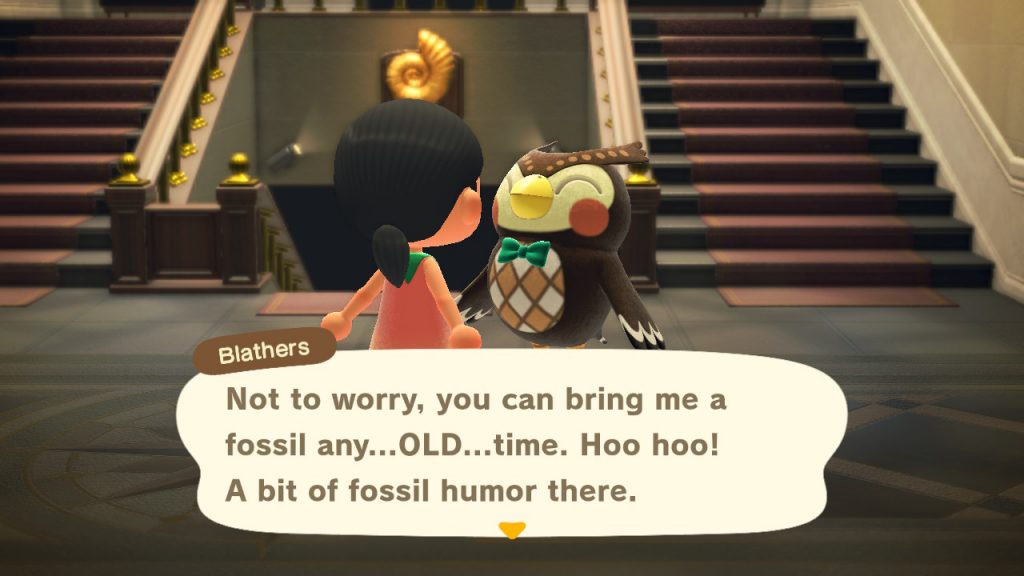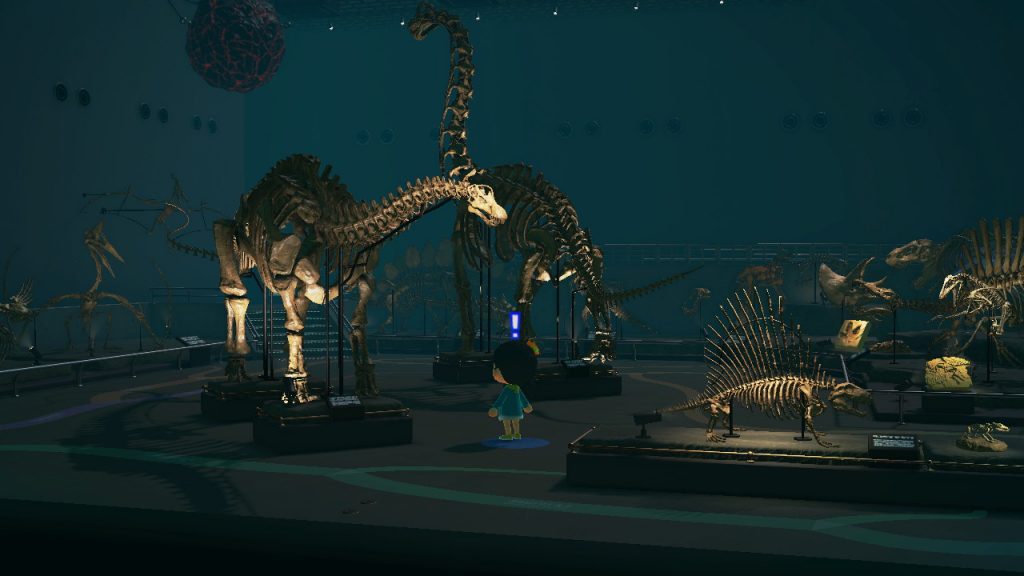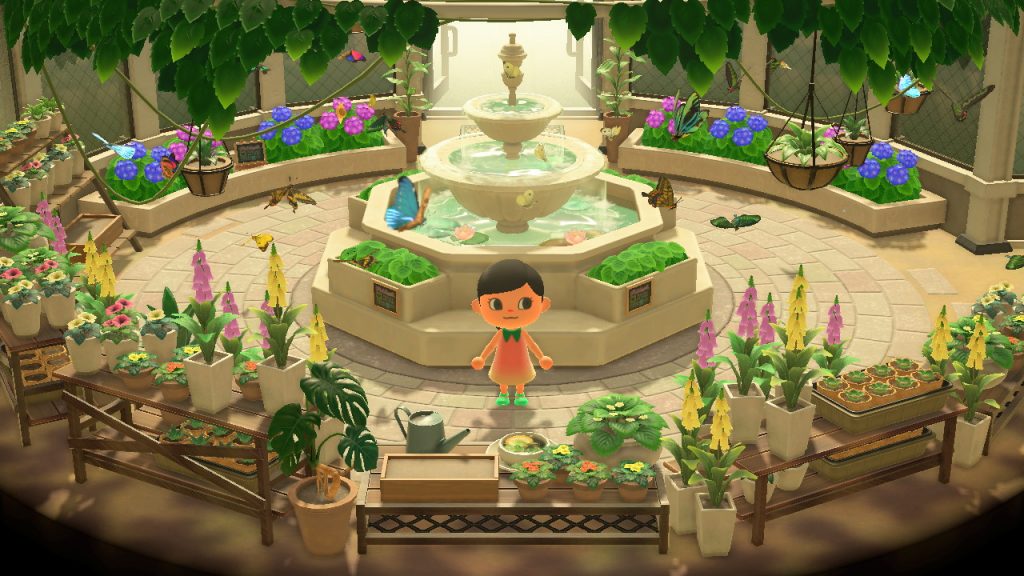This is a guest post by Alvina Lai. Alvina holds an MS in Library and Information Science from Pratt Institute, and a BFA in Photography and BA in Creative Writing from The New School. Their writing appears in The Mary Sue, Brooklyn Botanic Garden, and the NYT’s “Metropolitan Diary”; all of which can be found on their LinkedIn.
Game creators use museums in their world-building as a way to create a place for players to engage creatively with the game world. Museums in video games can serve as a narrative frame, or space, to motivate player actions, such as exploration and collection. In Animal Crossing: New Horizons, the museum takes from real-world art, history, and science. This post explores the Animal Crossing museum’s four galleries, the way object collection encourages play, and the way play prompts players with real-world questions.

The Animal Crossing museum is a 24/7 institution run by an NPC owl named Blathers. He analyzes fossils, collects donations, and provides information about them. The museum accepts fossils, fish, bugs, and art. The methods of obtaining these four kinds of objects vary. The four galleries that house these objects are also unique. All four galleries are completed when one of each object is donated.

Fossils
Fossils are buried in the ground, and four are discoverable in each island every day. When players find fossils, they must go through an appraisal process with Blathers to identify them. It is the only collectible that has this lottery system. If the appraised fossil is not in the museum collection, the player has the option to keep or donate the object (this is true for all donations). Blathers will also offer to tell the player a description of the fossil. If the player chooses to listen, Blathers will enthusiastically… blather, about it.
In the beginning, the fossil gallery will be empty. Museum placards for missing parts will ask for donations that players “happen to excavate.” Once appraised fossils are donated, they will appear on display in one of three rooms. They will be arranged by a chronological timeline, with designated paths on the floor that reference a recognizable scientific concept, the evolutionary history of life. The gallery starts with a room for early creatures such as the trilobite, a second room for dinosaurs such as the brachiosaurus, and ends in a room with the most recent era; in this last room (and in good humor), there are silhouettes of villagers from the game. The use of real scientific concepts and museum design, similar to, say, the Museum of Natural History in NYC, encourages interest in fossils and archeology. As Rebecca Mir mentions, collaboration between game designers and subject matter experts (whether they be historians, archeologists, or interior designers), is beneficial. In this case, expertise helps create an engaging, educational experience.
In-game, players hoping to find fossils will find themselves running around, shovel in hand, digging up the ground. In this case, the ground is their island. However, in real-world situations, archeology is more complex. Animal Crossing eliminates the complicated dialogue about ownership, whether it be related to land, cultural artifacts, or any other form of excavated history. Another inquiry to consider is about rarity. Which artifact a player gets depends purely on luck. Players can turn to Nintendo’s paid online subscription, which allows for online co-op playing, to trade fossils and other resources. In real-world artifact collection, individuals and institutions may go great lengths to obtain something. It is a video game trope to see villains cross ethical boundaries to get the rare creature, stone, or prophesied item. For example, some villains the Pokémon series exhibit this behavior when chasing or hunting rare Pokémon. While it is Animal Crossing’s style to avoid these darker questions, the in-game fossil digging process is no doubt inspired by reality.
A more lighthearted portrayal of the fossil collection process can be seen in Blathers. The owl’s enthusiasm and engagement with the player would be a winning quality in real-world museum education. Historically, museum curators were positioned as distant and authoritative, and educators more lecturers than conversationalists. Rika Burnham, the head of Education of the Frick Collection, writes and lectures extensively about the need for “conversation, discussion, and dialogue” as a part of the evolving museum experience. It has become practice now for educators to ask museum patrons about their thoughts and feelings, such as in the appointment-only Tenement Museum in NYC. Blathers’s dialogue seems designed to feel like such an interaction, even if it is scripted. He openly shows love for archeology and also offers down-to-earth explanations. If players bring objects previously catalogued, there is an option to allow Blathers to repeat his description, not unlike a museum or library inquiry. He is also a character from the first Animal Crossing game, which suggests that he has sustained some level of popularity among players. For an NPC, Blathers has enthusiasm, expertise, and approachability that can be admired.
Fish
Fish is another kind of item the player can collect. If the player has a fishing rod, they can fish in any body of water. The kinds of fish players can get depend on the body of water, the season, and the weather. Blathers will offer a description (although not with the same enthusiasm as with fossils) of fish donations.
The fish gallery, like the fossil gallery, is made up of three rooms. The fish are separated by types of water and by size. The fish gallery is designed well enough that the Monterey Bay Aquarium hosted Twitch livestream tours of it, using the Animal Crossing fish gallery as a space for public education.
As players try to complete the museum collection with one of every fish, they will inevitably come across trash. Trash can be used for crafting (so players may intentionally fish for trash), but it is usually an intentionally inconvenient part of play. In the context of New Horizon’s 2020 release, it is also acknowledgment of real-world pollution.
Players who inevitably find rare (and expensive) fish, will have to decide if they want to donate the fish or sell it. Do players support the public institution, or do they pay off the two million bell loan for the basement of their house? Cultural development vs. individual gain. Players are challenged to recognize their own priorities and values.

Bugs
Players catch buys by exploring their island and swiping the critters up with nets. Some bugs appear under specific situations, such as falling from a tree that the player shook or scurrying from rocks that the player hit with a shovel. Bugs also appear when certain environmental criteria are fulfilled. For example, the peacock butterfly requires the island to have cross-bred flowers. Like fish, bugs are seasonal. Because some bugs have complex needs, players may be inclined to search online or travel via the paid Nintendo subscription service to find islands that meet the necessary conditions. Non-subscribed players without this option may experiment, do online research, or come across situations accidentally, such as leaving fruit on the ground to rot. When bugs are donated to the museum, Blathers will be upset due to his hate and fear of bugs. Nonetheless, he will provide a description, and the bugs will be in the gallery unharmed.
The three sections of the bug gallery are split based on the environment. The first area is mostly for tree and water critters. The second room is a butterfly room. The third room is reserved for bugs that have their own glass cases. The third room also has a mini-lab that is aesthetically pleasing but has no functional value.
Bugs, like fish, also remind players that their real-world actions, whether it be littering or planting flowers, affects the environment. However, the peculiarity of having fish and bugs in a museum (rather than an aquarium, insectarium, or zoo) is an opportunity to discuss the idea of living things as collectible objects. Modern zoos in the Western world hail back to the 1700-1800s. Those zoos are remembered for their poor enclosures and mistreatment of living things. However, museums, aquariums, and zoos have evolved. For example, the New York Aquarium’s conservation program and exhibition displays talk about protecting the environment. The Museum of Natural History, mentioned earlier, often hosts a live butterfly exhibit, where they have a lab-like area that shows various stages of metamorphosis.
Similarly, in Animal Crossing’s museum, players can see a scuba diving set in the fish gallery and the mini lab in the bug gallery. While it is common (even expected) for cultural institutions to educate the public, it is actually the result of years of advocacy. In the late 1800s to early 1900s, librarian and museum director John Cotton Dana revolutionized the museum as an institution for public education. The design choices in Animal Crossing are inspired by real-world institutions choosing to promote public education and forward-thinking science with great consideration for all forms of life.
Art
To acquire art, the player visits Redd, a shady fox art dealer who sells his merchandise off a small boat parked in a hidden cove located at the back of the island. However, buying art isn’t as simple as an exchange of bells, although it is worth noting that the player does pay for art pieces. Some of the art from the boat’s selection is fake; the player has the option to look closely at each piece before purchase. Genuine pieces will look like their real-world counterparts, while fakes will have details such as a wristwatch on the Discobolus of Myron, or star earrings on Girl with a Pearl Earring. When donated to Blathers, he will not provide a description as he does with the other objects. Instead, visitors may go read the wall placards in the gallery.
Because the art in the game is based on real-world art, the museum provides factual information on its placards. For example, the object called famous painting has the description, “Mona Lisa, Leonardo da Vinci, circa 1503, Oil on poplar.” There’s also a short description of the elusive nature of her smile. The use of the in-game art placard is just like real-world museum art placards, which encourages art history education.
The placard is a good segue to discussing donor credit. In the game, the player’s name will be displayed for each item they donated. It can be the Mona Lisa, a T-rex tail, or the golden trout. In real-world museums, the donor is often a wealthy or powerful individual who may publicly include their name as part of an object’s provenance. Both in-game and in the real world, it can be for bragging rights. However, real-world donations are often tied to notions of wealth, power, and elitism. Even in Animal Crossing, the art is usually purchased, so players who have more saved up are more likely to be able to donate. At least the donation process in Animal Crossing is without the complex ties to family inheritance, corporate corruption, or some other hodgepodge of history textbook drama. Players can just sell some fish and be on with it…
The fake art is part of Redd’s character trope (a shady fox), but also raises the question of the value placed on art. Players cannot donate fakes to the museum, but they can decorate their home or island with them. Players may intentionally buy fakes for that purpose. Museums historically debated the value of fakes, as well as the value (or lack of value) of mass-produced and reproduced artwork. Most real-world museums may not want a fake Mona Lisa, but they are willing to sell postcards of her. Scholars Stefanie H. Wolz and Claus-Christian Carbon (2014) studied the cognitive and emotional variables that influence viewer perception of art. The study revealed how terms such as “originals” and “copies” change viewer perspective. They speculate that uniqueness and symbolic value provide emotional value for a viewer. If a museum has a fake work, or only copies, viewers may not feel positive about their museum experience, and the museum would lose patrons. However, if a museum has authentic work, patrons may have positive emotions; they may feel inclined to buy a postcard (thus funding the museum) to commemorate the experience. In Animal Crossing, the museum wants the authentic, not the fake, demonstrating the idea that uniqueness or authenticity has value.
Redd’s shady boat also prompts the question, where does art in a museum come from? Like with the fossils, Redd’s mysterious arrival to the island draws attention to the opaque museum acquisition process. Earlier, I mentioned how villains in video games may cross ethical boundaries to get their rare creature, stone, or prophesied item. More explicitly, real-world art and artifact acquisition has roots in violence and theft. The famous museum heist scene in Marvel’s 2018 movie Black Panther highlights the theft and violence of art and artifacts that come from unequal economic and political power dynamics on the international level. By bringing this issue to public awareness, pop culture has created space for social activism. That activism has then led to change. For example, western institutions, such as The British Museum, are currently in the process of returning looted objects. Returning to Animal Crossing, Redd’s design of being the suspicious art dealer is based on this history. When players buy from Redd, it can look like players are participating in the process of willingly buying stolen or looted art. This leads to the next question, about player intent.
At the individual level, a person, such as a wealthy art collector, may choose to keep their art collection private. Other collectors, such as the Rubins of the Rubin Museum of Art, may create a museum for public use. Others may choose to donate to existing institutions like the Metropolitan Museum of Art. In Animal Crossing, players may donate to the museum, but some players choose not to. Some players display their fossils and art (both authentic and fake) on the island instead. Players can put fossils on the beach, or on the edge of a cliff. They call these displays a “museum” as well, even though none of it is in the museum building. Because the player is just as free to fill the museum as they are to ignore it, players can become personal collectors, displaying art at home or around the island. NPC villagers will admire anything set around the island, so why put it in the museum building?
This leads to the final question. Why does the museum exist in Animal Crossing in the first place? It encourages exploration, experimentation, and learning. Players are rewarded for running around their island in search of fossils and critters. They must manipulate the environment by planting flowers or growing trees, which leads to the fun and creative process of landscaping and terraforming. Players get to learn from Blathers every time they donate, and there is a satisfaction that comes from completing the museum collection. The museum encourages continuous, easygoing, educational, thoughtful play. Museums exist in other games too, and they encourage play and thought in a similar way. Tomas Brown describes museums as story drivers and world enrichers. Players would have less incentive to explore their whole island every day if not for the fossils buried across it. The museum is also a place where NPC villagers visit and is a topic of the character dialogue. Brown also describes museums as political devices. While Animal Crossing does not explicitly talk about museum history, players can see the influences of museum history in its design. This article discusses all the ways the museum’s design, whether it be the mini-lab or the art gallery placards, is a result of museum evolution.
Animal Crossing is one museum in a timeline of museums, both in real life and in video games. Its design may influence future museums in video games. It also impacts the way viewers perceive museums in the real world. Animal Crossing’s museum reinforces the expectation that, in a museum, there will be a practice of interactive participation and learning, value in collection development, importance placed on unique art and artifacts, and the idea that museums are places of public learning. They are places of research, preservation, and appreciation. In Animal Crossing, players can appreciate these ideas as they roam their island, shovel in hand.
References
Wolz, Stefanie H. and Claus-Christian Carbon. “What’s Wrong with an Art Fake?: Cognitive and Emotional Variables Influenced by Authenticity Status of Artworks.” Leonardo, vol. 47 no. 5, 2014, p. 467-473.

1 Comment